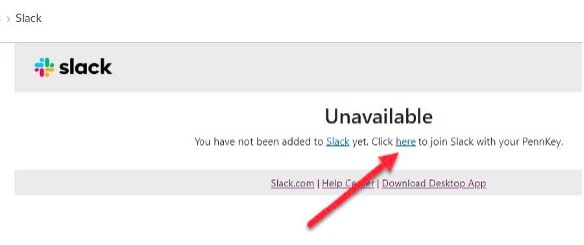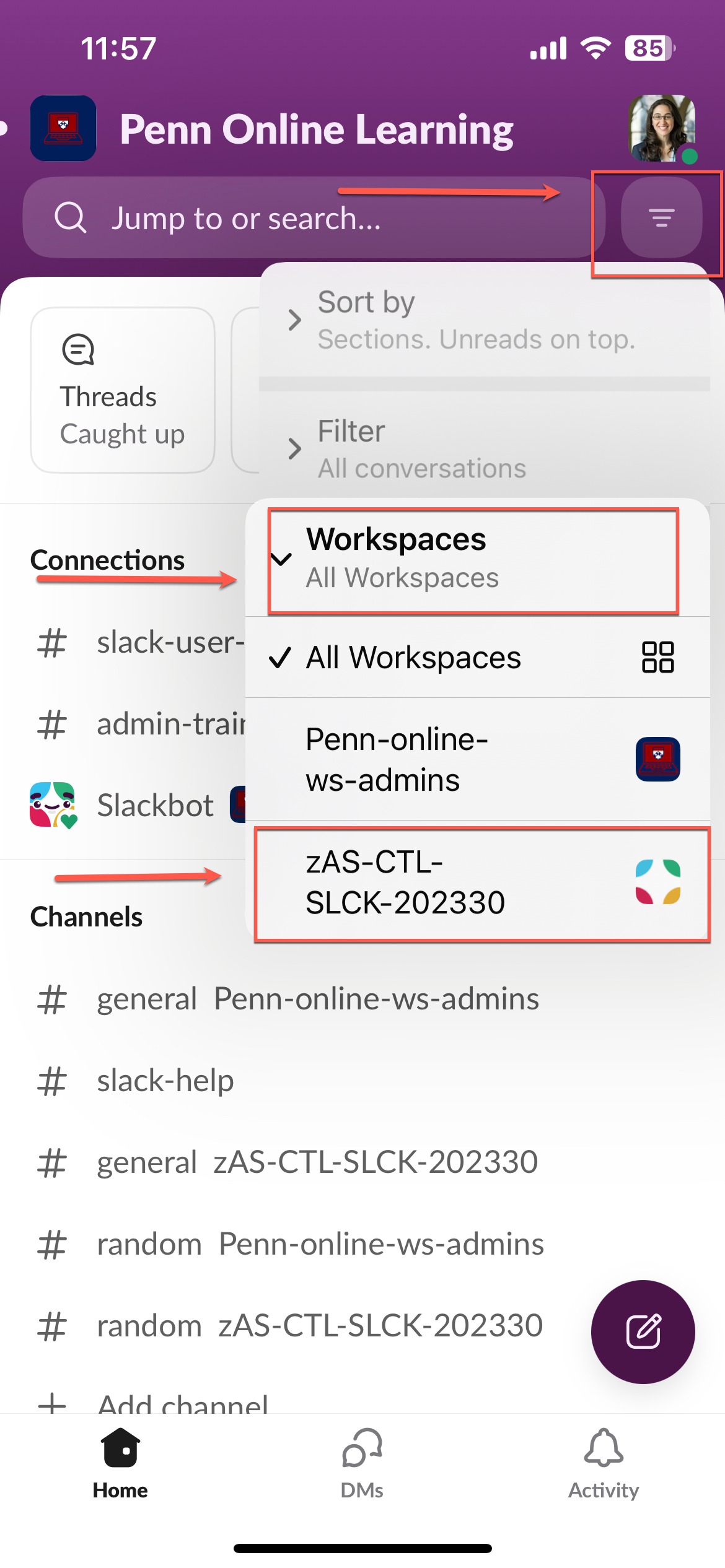
TABLE OF CONTENTS
- About Slack
- Accessing Slack for the First Time
- Filtering Slack to Show a Workspace
- Slack Interface
- Personal Slack Settings
- Slack Workspace Setup Recommendations
- Additional Resources & Support
About Slack
Slack is a communication tool that allows for quick messaging among instructors, TAs, and students while creating a searchable space that anyone in a course can use to quickly have their questions answered.
Slack is only available for online courses as a pilot in AY23-24. If you want to use Slack in an online LPS course, please email online-learning-help@sas.upenn.edu.
The Slack integration with Canvas provides a Coursebot that notifies students about changes to their Canvas course, (e.g. a new announcement or a due date has been updated). Slack does not have grade passback to the Canvas gradebook but can serve as a communication forum for your students and facilitates both synchronous and asynchronous uses.
Accessing Slack for the First Time
- Download the Slack desktop app—you can also use the browser version from your desktop, but we find that the best user experience is in the desktop app: PC / Mac
- Download Slack mobile app—Slack’s mobile capabilities are quite robust and useful for course communication: search for Slack in the iOS App Store or Google Play
- From a web browser on your desktop or laptop (not your mobile device) click the Slack button in your Canvas site’s navigation menu.
- If this is your first time logging into the student Slack workspace, you will need to log in with your PennKey username and password.

- After logging in with your PennKey, please return to your course and once again select Slack from the course navigation, or, refresh your page. Then, please follow the prompts to access the Slack workspace for your course. You can choose either option (Slack Desktop App or Slack Web App).

After completing these steps, you should be able to access the course Slack workspace from your desktop Slack app or mobile device Slack app and will no longer need to click on the Slack button in the Canvas site.
Students will follow the same steps to access Slack for your course.
Filtering Slack to Show a Workspace
By default, Slack hides your course's workspace. You will need to use these steps to make a course workspace visible:
Desktop App
a.) If you have not used Slack for an online course before, you will only see the Penn Online Learning workspace, which is your course's workspace--you can proceed to step 3 if this the case.
b.) If you have used Slack for an online course before, please click the downward-pointing arrow under "All Workspaces" and select your course from the list. The following screenshot shows an example of what this looks like.

Mobile App
a.) If you have not used Slack for an online course before, you will only see the Penn Online Learning workspace, which is your course's workspace--you can proceed to step 3 if this the case.
b.) If you have used Slack for an online course before, please click the three-lined button on the upper-right side of Slack. Then, click Workspaces > the workspace for your course. The following screenshot shows an example of what this looks like.

Slack Interface
Workspace
Each course has one Slack workspace that is then divided into channels and lists all students on the roster for direct messaging.
Channels
We recommend trying to set up most channels before the course is published and making them "Default Channels" so all students are added to all channels upon entering the workspace. See more guidance below.
Channels act like folders in Slack; they sort Slack into discussion areas centered around a topic. Channels can be either public, which means accessible for the whole course roster, or made private for certain members to communicate (e.g., the teaching team, or small workgroups of students). When creating a new channel, use a descriptive name so members know what that channel is about, e.g. #module1,#course-faqs, etc
When members post in a channel, other members can reply in threads to that post to keep the channel organized. Workspace members have multiple ways of responding to a post by using Slack's robust message editor. The message editor options include posting text, adding a gif, sending a video, sending an image, sending a voice recording, or reacting with an emoji.
After setting a descriptive channel name, we recommend choosing to make the channel a default channel, which means all new students will be added as a member of the channel when they join the Slack workspace instead of having to be invited to each channel individually. Typically only the #general and #random channels are default channels to the whole course roster.
Direct Messages (DMs)
Direct messages are possible between anyone on the course roster. This provides students with another avenue to reach others in the course. It is good practice to remind students to use the public channels when possible so other students may learn from their questions.
Personal Slack Settings
Profile
By clicking on your user initials inside Slack you will be able to edit your profile to say more about yourself and add a custom user profile image.
Notifications
All members can tailor their Slack notification settings in the following ways:
- Members can configure notification triggers so they are alerted whenever they receive a direct message, are @ mentioned in a channel, or if a certain keyword is mentioned in a channel.
- Members can set up a notification schedule so they are only alerted to channel updates during a certain timeframe and any messages received during a quiet time are collected and saved for review the next time that member logs in
- Members can also temporarily pause all notifications, completely mute a channel if the channel becomes too busy, or set notifications on a channel-by-channel basis if they want to get more granular.
Personal Slack status
This setting can be found by clicking on your profile picture or initials. This can be used to show others if you are available, do not wish to be disturbed, or are currently on vacation. Personal Slack status is completely customizable. To learn more about this feature please see Slack's Status and Availability guide.
Slack Workspace Setup Recommendations
- Create your course channels and add descriptions to channels so all users understand what each channel is for.
- Check the settings for the Slack workspace to make sure everything is how you would like it.
- Add an image for your course workspace to add a personal touch.
- Create your user profile and add a user image.
- Create an etiquette guide and a welcome message that you can add to the #general channel so all students know what to expect in the space.
- Fine-tune your notification settings.
Additional Resources & Support
- Slack Help Center
- Slack's Quick Start Guide
- Email online-learning-help@sas.upenn.edu for support questions.
Was this article helpful?
That’s Great!
Thank you for your feedback
Sorry! We couldn't be helpful
Thank you for your feedback
Feedback sent
We appreciate your effort and will try to fix the article